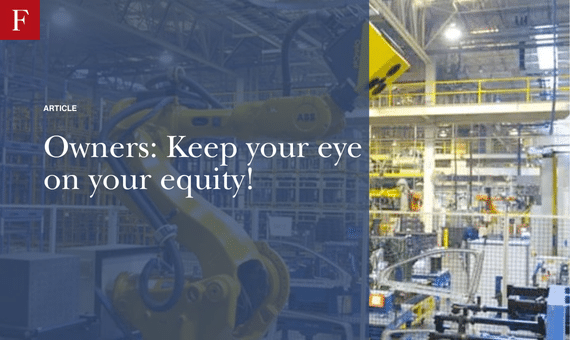
Owners: Keep your eye on your equity!
If you’re a precision machine shop owner, there are a lot of things to like about the industry right now. With a general resurgence of U.S.-based manufacturing, driven in part by extensive public (and not so public) investment in domestic manufacturing capability and technology-driven industrial innovation, owners see a bright future. In some sectors, your biggest problem may be keeping up with demand.
Many shop owners had been contemplating selling because valuations remain at healthy levels, albeit off the 2021-22 peak, fed by the post-pandemic rebound and private equity’s desire to put their capital to work. But with business healthy, many owners are now thinking they should continue to grow the business and cash in down the road.
But does that mean your business is destined to continue to get more valuable as revenue grows? Not necessarily. It’s more complicated than that.
The dynamics of the business are changing, the basis of competition is evolving, and owners are strongly encouraged to develop a strategy that is equity-focused, not sales-focused. An equity strategy is one that focuses on maximizing your invested wealth, after taxes, come your retirement date. Smaller independent businesses have a high-risk profile due to business concentration and lack of liquidity, and that’s particularly true in an industry that’s consolidating. An equity strategy explores all your options to grow the value of your business interests and your overall wealth over time. It keeps the eye better trained on the strategic risks of the business and the risks to the family balance sheet over the long term.
Where many owners err is in thinking that their equity in the business is growing just because their sales are growing. But they lose sight of the fact that company valuations—what prospective buyers are willing to pay—are based on a complex combination of company-specific, industry-specific and macro-economic factors; some you can influence, and some you can’t. Your equity strategy, whose purpose is to secure your personal and family’s needs and goals, needs to be founded on a realistic assessment of both risks and opportunities and a forecast of how these factors may affect future value.
An equity strategy for a consolidating industry
FOCUS has been in business for almost 40 years and we are well versed in the dynamics of industry consolidation. The precision machining business has all the classic drivers of a consolidating industry, and there is no way around it. Driven by money, technology and the supply chain itself, the industry is “in play” and we have a very good idea of where it will end up. If it follows the classic pattern, the strong will get stronger and the weak will get weaker.
Scale and capital are the trump cards that will drive the business to max efficiency that the supply chain will demand, and most importantly, sustainable margins. That requires you as an owner to cast an eye forward, assess your competitive and financial strengths, the stage of the financial cycle we’re in, and plan a navigable route to the equity goal and timing that works for you. You will find there are multiple ways to get there—and just as many ways you won’t.
The profit squeeze
In a highly fragmented industry entering into major consolidation, the bottom third of participants are typically most at risk and many won’t survive. Partnering may be a necessity, not a choice. Advanced technologies and automation are significantly upping the financial ante. New competitive technologies, like additive and new materials, can create additional headwinds. These advances demand new skill sets, inclusive of management, not developed on the shop floor as they once were. All roads lead to the need to scale up, and that takes capital. It’s hard to compete at the poker table with the shortest chip stack in the room.
The usual pattern is as follows: The larger, better capitalized (PE-backed) regional players invest for cost efficiency, attract the best talent, expand their capabilities, and generally make life easier for their customers. Infotech and connectivity increase transparency, putting pressure on old relationships. Margins come under pressure to the point where owners will have to make costly investments to remain competitive—and profitable—or get left behind and possibly be put out of business. But if you can’t afford to make that investment to stay in the game, it’s a path to eventual trouble. Indeed, just because you want to remain in business doesn’t mean you should.
We’ve seen this scenario play out in plenty of other industries—from local print shops to tire shops to semiconductors—where small firms were pushed out by more efficient players or overtaken by new technology, or both, to the point that only a small number of large players remain.
The same thing is happening in the precision machining business, although it’s still at an early stage. But make no mistake that it’s going to happen. Bigger companies around you are getting more efficient and are able to work on tighter and tighter margins. Eventually those shops that don’t make the investment won’t be able to compete on margins. Jabil, a goliath serving the electronics industry, has an EBITDA margin of less than 7%, and Apple loves it. Precision machining operates at 18-22% EBITDA margins, so there is a lot of fat to cut out, and we bet Boeing will like that, too.
We estimate that there are 4,000 to 6,000 machine shops across the U.S., the vast majority of which are one facility, family-owned businesses. That’s simply too many for large manufacturers to deal with. They want to deal with a smaller supply chain that can produce parts the fastest, at the lowest cost, and with real-time transparency. That means those with the best machines, the lowest cost of capital, strong buying power, and the best information systems.
It’s no news that metalworking has undergone a major transformation in actual production and materials handling technologies over the last few years. More recently, we have observed the progressive importance of broader scale efficiencies and technologies, designed to get the most done with the least amount of labor—a terribly scarce resource at the moment—such as in the supply chain and inventory management. It takes scale to invest in technologies like automated guided vehicles.
If you’re a smaller- to medium-sized machine shop, you likely can’t afford all the technology you will need to compete with the technology suite of the consolidated players. Simply put, technology is making the precision machining business a more expensive place to play in. And if you can’t afford the investment, you may find yourself between the proverbial rock and a hard place.
Private equity’s role
Right now, the private equity industry sees the precision machining business as fertile ground for investment: a highly-fragmented industry ripe for consolidation into larger companies with the efficiencies, quality, buying power and financial footprint necessary to compete for market share.
The question is, how long will this last?
We don’t pretend to have a crystal ball. But one thing we do know as investment bankers is that the M&A market, like the stock or housing markets, is cyclical. Company valuations can change significantly even if the overall business grows, and we saw this in 2023.
Here’s a scenario to avoid: Let’s say you have 20% profit margins today and your plan is to sell in four or five years. But then your margins drop to 15% or less because of competitive pressures. That’s a 25% hit to your equity. If interest rates rise (which they did last year), which raises the cost of capital to PE buyers, and they drop the multiple they can pay from 7X to 6X or 5.5X, you may have lost 40% of your equity over that time, even while growing your business. In other words, the M&A cycle matters to the equity strategy.
And there is a new dynamic in 2023-24. Post Silicon Valley Bank, and pending commercial real estate distress, the bank financing market (which both PE and strategic investors rely on) has become considerably more conservative, reigning in leverage and raising risk assessments. That means it’s getting harder, not easier, for lower margin businesses to partner up. As we’ve written in prior articles, playing hard to get in a consolidating industry can be costly to an owner.
One way risk can be avoided is not by exiting the industry, but by partnering with strength, and potentially getting a “second bite at the apple.” This is because PE-backed firms will eventually sell, usually on a five- to seven-year horizon, allowing owners and managers in the system to sell up again at an even higher multiple. Putting some of your chips into more diversified investments reduces risk. This might play better to the owner’s long-term equity strategy than staying the course as an independent. Generally, an owner who retains 20-25% of a partnership will see 70%-100% of the original sale price on the second bite, if the typical objectives of the partnership are met. Such is the power of scale.
Still, owners who love the game and want to continue as an independent in a consolidating industry need a different strategy—perhaps by raising mezzanine capital and being the acquiror … and building sustainable scale and value for an exit 15 years down the road. That can work, too, albeit with a higher degree of risk.
Every owner should sit down with their advisors (and family) and formulate an equity strategy and business action plan. If you’re at the lower end of the revenue spectrum, we think that’s especially critical, because the organic growth model that worked before is going to get increasingly risky going forward.
FOCUS has been in business for almost 40 years and can help you come up with a solution that meets your company’s and family’s needs. If you have follow-up questions for Craig and the Advanced Manufacturing team at FOCUS, please contact him at [email protected] or 541-390-5005.















